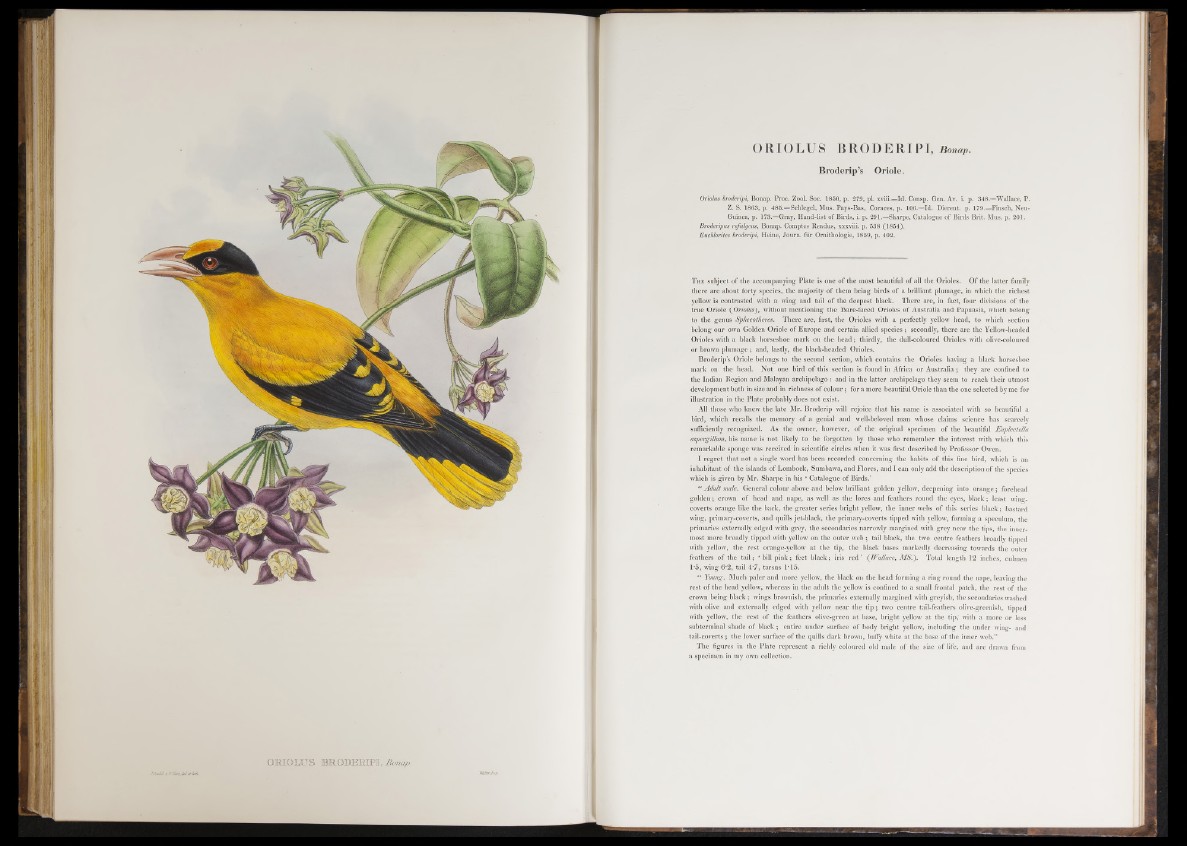
OBJOIXT S BROBJEßlPI, Bonap.
O R I O L U S B R O D E R I P I , Bonap.
Broderip’s Oriole.
Oriolus broderipi, Bonap. Proc. Zool. Soc. 1850, p. 279, pl. xviii.—Id. Consp. Gen. Av. i. p. 348.—Wallace, P.
Z. S. 1863, p. 485.—Schlegel, Mus. Pays-Bas, Coraces, p. 10.6.—Id. Dierent. p. 179.—Finsch, Neu-
Guinea, p. 173.—Gray, Hand-list of Birds, i. p. 291.—Sharpe, Catalogue of Birds Brit. Mus. p. 201.
Broderipus refulgens, Bonap. Comptes Rendus, xxxviii. p. 538 (1854).
Euchlorites broderipi, Heine, Journ. fur Ornithologie, 1859, p. 402.
T he subject of the accompanying Plate is one of the most beautiful of all the Orioles. Of the latter family
there are about forty species, the majority of them being birds o f a brilliant plumage, in which the richest
yellow is contrasted with a wing and tail of the deepest black. There are, in fact, four divisions of the
true Oriole (^Oriolus), without mentioning the Bare-faced Orioles o f Australia and Papuasia, which belong
to the genus Sphecotheres. There are, first, the Orioles with a perfectly yellow head, to which section
belong our own Golden Oriole of Europe and certain allied species; secondly, there are the Yellow-headed
Orioles with a black horseshoe mark on the h ead ; thirdly, the dull-coloured Orioles with olive-coloured
or brown plumage; and, lastly, the black-headed Orioles.
Broderip’s Oriole belongs to the second section, which contains the Orioles having a black horseshoe
mark on the head. Not one bird of this section is found in Africa or Australia ; they are confined to
the Indian Region and Malayan archipelago: and in the latter archipelago they seem to reach their utmost
development both in size and in richness of colour; for a more beautiful Oriole than the one selected by me for
illustration in the Plate probably does not exist.
All those who knew the late Mr. Broderip will rejoice that his name is associated with so beautiful a
bird, which recalls the memory of a genial and well-beloved man whose claims science has scarcely
sufficiently recognized. As the owner, however, o f the original specimen o f the beautiful Euplectella
aspergillum, his name is not likely to be forgotten by those who remember the interest with which this
remarkable sponge was received in scientific circles when it was first described by Professor Owen.
I regret that not a single word has been recorded concerning the habits of .this fine bird, which is an
inhabitant of the islands of Lombock, Sumbawa, and Flores, and I can only add the description of the species
which is given by Mr. Sharpe in his ‘ Catalogue o f Birds.’
“ Adult male. General colour above and below brilliant golden yellow, deepening into orange; forebead
golden; crown o f head and nape, as well as the lores and feathers round the eyes, black; least wing-
coverts orange like the back, the greater series bright yellow, the inner webs of this series black; bastard
wing, primary-coverts, and quills jet-black, the primary-coverts tipped with yellow, forming a speculum, the
primaries externally edged with grey, the secondaries narrowly margined with grey near the tips, the innermost
more broadly tipped with yellow on the outer web; tail black, the two centre feathers broadly tipped
with yellow, the rest orange-yellow at the tip, the black bases markedly decreasing towards the outer
feathers o f the ta il; ‘ bill p in k ; feet black; iris red ’ ('Wallace, MS.'). Total length 12 inches, culmen
1*5, wing 6 -2, tail 4'7, tarsus 1*15.
“ Young. Much paler and more yellow, the black on the head forming a ring round the nape, leaving the
rest of the head yellow, whereas in the adult the yellow is confined to a small frontal patch, the rest o f the
crown being black; wings brownish, the primaries externally margined with greyish, the secondaries washed
with olive and externally edged with yellow near the t ip ; two centre tail-feathers olive-greenish, tipped
with yellow, the rest of the feathers olive-green a t base, bright yellow at the tip,' with a more or less
subterminal shade of black; entire under surface o f body bright yellow, including the under wing- and
tail-coverts; the lower surface of the quills dark brown, buffy white at the base o f the inner web.”
The figures in the Plate represent a richly coloured old male of the size of life, and are drawn from
a specimen in my own collection.